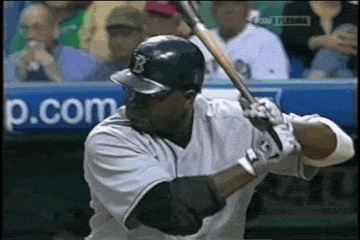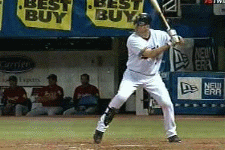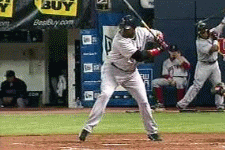
Brandon Allen was probably looking forward to improving upon his 2009 MLB performance, until the Diamondbacks signed free agent Adam LaRoche to a one-year deal. Was it a wise investment given Allen's impressive power display at Triple-A Reno (12 home runs in 147 at-bats), or were his 40 strikeouts in 104 at-bats with the big club too glaring to ignore?
A big bodied slugger with power for days, Allen is able to generate decent bat speed thanks to his large frame and well above-average strength. His power is his main tool. When he squares the baseball it generally goes a long way. But there are a number of inefficiencies in his swing that may hold him back from being able to make enough contact at the Major League level for his power to be usable.
Lower Body
Allen drastically changed his stance from the early part of the 2009 season to his time in the Arizona Fall League. More than likely in an effort to improve on his strikeout problems in his time with Arizona, Allen switched from a narrow, almost lock-legged set up to a wide and spread out stance. For most hitters, this loss of movement -- and therefore, momentum -- would severely sap their power. But with Allen's strength, he doesn't need a lot of momentum to put a charge into the ball. He only needs to square it.
With his previous stance, Allen could get caught on his front side by pitchers who changed speeds effectively. Now that he's spread out, his lower body gives him a better chance of staying balanced -- which his upper body ends up negating, more on that later.
Allen sways back slightly as part of his pre-pitch rhythm before aggressively planting his front foot into the ground. There is a small coil with his front leg, but he does not do a good job of creating a solid rear leg to launch from. His weight is centered in the middle of his body until he decides to stride, when the majority shifts to his front leg.
Allen has a small stride and gets his foot down quickly, but almost to the point of rushing his swing. If he could create some form of a rear hip load via starting pre-loaded or a better coil, Allen would be able to slow down his lower body movements and gather himself over his rear leg before moving forward.
Upper Body
Allen pushes his hands back away from his body for a load. This is something a strong human can get away with against non-Major League pitching, but at the highest level the inefficiencies created by this type of load are glaringly magnified.
Allen's load detaches his hands from his body, interrupting the sync with his body's movements and leaks the energy that is created by a load. This doesn't give him the proper stretch need to generate optimum swing quickness and doesn't allow him to create good separation between his upper and lower half, along with the resistance for his hands to be able to hold back when fooled.
Proper separation is the key to creating optimal bat speed and quickness and resistance goes a long way toward maintaining a rear hip load that the lower body creates. The goal is to create and gather as much energy as possible while staying centered over the rear leg, and Allen's load disrupts this process.
Adjustments Needed
Imagine if there was a piece of high tensile strength fishing wire tying the hands to the rear shoulder, with just enough slack to allow some freedom of movement to go up and down (to adjust the swing plane) but not too much slack to ever let the hands get too far away from the body. Every great hitter maintains a position where their hands are "tied" to their body during the load. Then when they launch, there is still a sync to the body's and hand's movements, and the energy that was created by the load is maintained and fully unleashed. When Allen pushes his hands away to load, this basically cuts the imaginary fishing line, and the energy he created is lost and the ever so important separation and resistance is never created.


David Ortiz and Joe Mauer -- seen above -- both have very small and simple loading patterns, and ones that Allen could model his adjustments after. Both Ortiz and Mauer have slightly different loads, but the principal is the same -- small, efficient, and everything stays contained -- no loss of energy or leaking forward. Notice how well both maintain their hands being tied to the body in the load. They both get enough negative movement to create a stretch and separation, but not too much that the hands ever get away from the body -- quite the opposite of Allen's loading action. If Allen were to incorporate similar loading patterns to either one of these hitters into his swing, his upper body inefficiencies would be minimized and his swing quickness would vastly improve.
Also take note of how well Ortiz and Mauer gather themselves over their rear legs before launch. Allen doesn't give himself enough of a chance to gather everything, forcing him to rush and get to his front side too soon.
I've touched on Allen's lack of separation caused by his poor load. Apart from the extra torque created by separation of the upper and lower halves, one hidden advantage is the hips ability to assist the hands by pulling them through the zone. Just a little extra oomph and assistance that can make a world of difference in hand speed.

This clip is isolated solely on Ortiz's unload. Notice his hips getting ahead of his hands -- "leading the way" as Ted Williams loved to say -- and helping his hands power through the zone and deliver the barrel to the ball. With Allen's lack of separation, he misses out on this valuable asset to the swing.
Allen's lack of resistance by his hands hinder his ability to wait back against good off-speed pitches. There just isn't enough resistance to hold his body back from committing too soon and losing his weight early. Even with his current set up, some resistance and separation would go a long way toward Allen being more in control of his body and upgrading his swing quickness, which would allow him to wait longer. A better rear hip load would allow him to stay centered over his rear leg. Allen would be a vastly different contact hitter and would be able to unleash his immense raw power on a daily basis.
Here's a link to some video of Allen's swing.
Closing Thoughts
Brandon Allen certainly has the raw power to be in impact bat at the Major League level, but he still has question marks about making enough contact to be an everyday player. As it stands, he profiles as a power bench bat who will have the platoon advantage. With Allen's need for more polish and refinements, I would say that the Adam LaRoche signing is a good deal for the Diamondbacks. Allen will get more time at Triple-A to learn and adjust his swing, while Arizona gets a very productive bat to plug into their lineup everyday in LaRoche. At the same time, if Allen does not shore up his inefficiencies, he may never be able to be an everyday player.
Update
Recently recalled after laying waste to Triple-A (again), Brandon Allen launched a prodigious shot against the Brewers on July 19th, 2011. Comparing this swing to others, I'm liking what I'm seeing. The push during his load is less pronounced, and he engages his hands in a much more aggressive manner. His hands lower a bit more during his load, and are in a much stronger position at launch. He hasn't lost anything during his load, like would do slightly in past years. Upper body wise, he is more compact, more efficient, and has a bit more bat speed -- more on this below.
It's important to note what he does with his lower half and middle- he's doing a much better job of getting his lower half running ahead of his hands. Spatially it's not a huge amount, (as there shouldn't be) but there is more than before. Comparing the timing of the forward movement of his hands vs his rear hip and knee, the knee starts to turn the corner a fraction of a second sooner, which is the proper timing of the swing sequence.
Take note of his jersey at the :37 mark in the first link above. Focus on the wrinkles, and how his jersey becomes more wrinkled during the separation phase of his swing. Now, if his jersey is stretching, then what do you think his core is doing? Short answer- stretching. That stretch in his core is building elastic energy that will fire like nobody's business when he launches his swing. As I illustrated earlier, it's always a good thing to have a large elastic muscle group pulling a small bone structure (I.E. hips/core pulling the hands) through the zone. That's called efficiency, not having to power the swing with pure strength. Or a non-active muscle group, I.E. shoulders or arms, that really have no bearing on any athletic movement. The proper sequence of movements and the stretching/firing of the elasitcally charged core is where the majority of your bat speed should come from. Allen's improved core stretching and compaction of his upper body combine to make his swing even faster, which is slightly scary.
It still remains to be seen whether Allen can make enough consistent contact to be an everyday player, but he's taking a large step in the right direction. At minimum, the balls he does square up are rather likely to end up lopsided.
Follow Steve Carter on Twitter.
